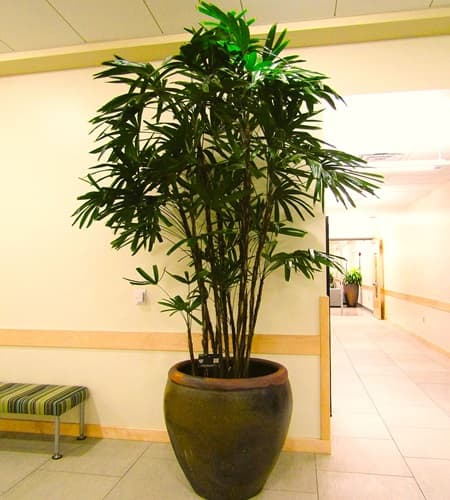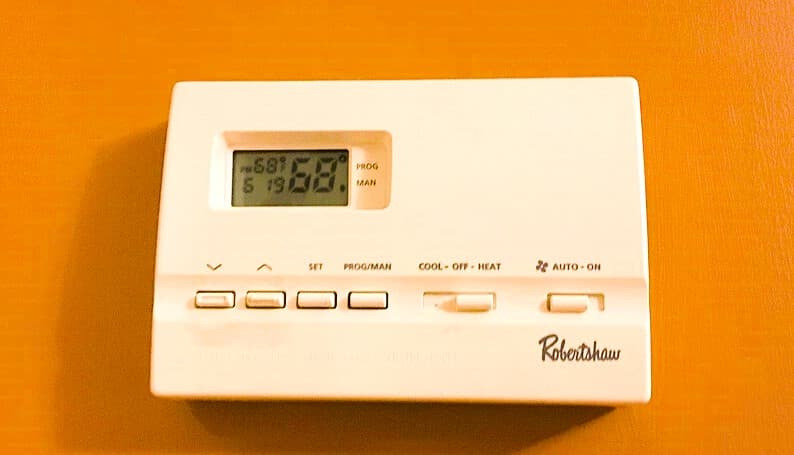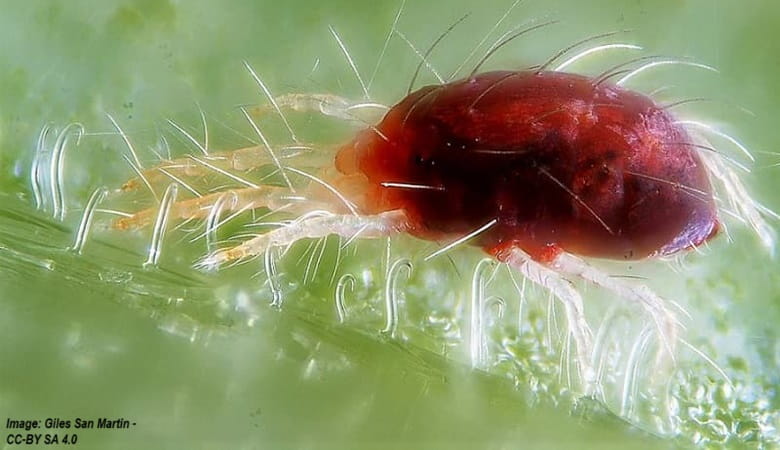- Home
- Caring For Palms
- Indoor Palm Care
Caring for Indoor Palm Plants - Your Tips Guide
Wondering how to go about caring for indoor palm plants? We offer our free guide, with lots of tips for caring for these tropical specimens. Learning how to care for indoor palms isn't just about keeping them in existence; it's about helping them thrive. Even if they'll be slow growing plants.
This guide helps you start on your journey, for having the best results for beautiful palms inside your home.
Or maybe you already have indoor plants, but you're a newbie to this lush world of indoor palms. Either way, the tips we have can help you assist your indoor palm to live its longest life.
First tip is to remember, every palm – and plant parent (you!) – is a little bit different. You'll find there's plenty of chances to create an environment that is warm, comforting, and inviting to your indoor trees. For that bit of tropical flair.
Feeling overwhelmed by so many palm trees?
You're not alone. We Understand your headaches! At Mission: Palm Trees you'll find clear answers to questions & Step-By-Step Guidance, from real people. With solutions to help. No puzzling shoptalk. No tiring research. So it's easy & fun for you.
Continue scrolling on down for all your needs in caring for indoor palm plants. Or you can jump right to any of these topics we cover, by clicking them...
Attack by Bugs & Pests! Yuck!!
Your Potting "Soil" Guide>
When is the Proper Timing for Repotting?
Fertilizing Requirements for Indoor Palms>
Your Overall Ongoing General Maintenance>
Indoor Palm's Important Lighting Needs>
Precautions When Giving Palms Water>
Handling Humidity Needs>
Should I Care About Pruning Fronds?
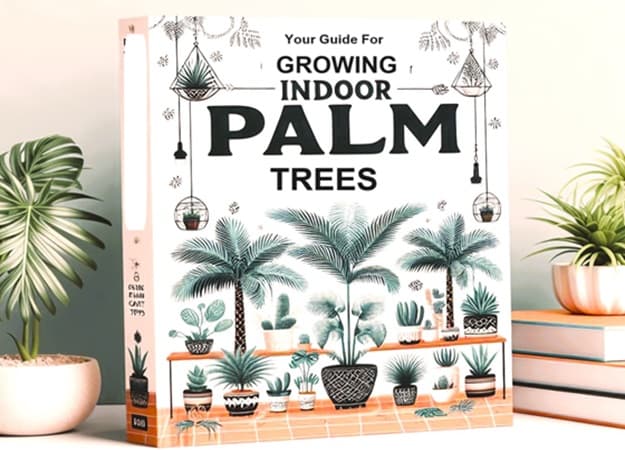
FTC Disclosure: If you purchase via a link/ ad on this site, we may earn a small royalty. With no added cost to you. Thanks much for any looks and/or orders! Details>
How to Grow Palm Trees Indoors With Proper Light
Let's look at sunlight you'll provide. Important when caring for indoor palm plants. Indoor palms need some amount of light to create food for themselves. That's their best way, with photosynthesis.
Out in nature, most types of palms love direct sunlight. But think about your indoor palm's native habitat. They're used to growing underneath taller outdoor palms & tropical plants. Where they're getting indirect light. Where bright light won't reach them. So for indoors, some palms will naturally grow in lower light.
How Much Light Do Indoor Palms Need?
Indoor palm plants need bright, filtered sunlight. Some a bit more than others. But never bright light. One important lighting tip: it's best To Buy Palms which have been grown for a year in low-light conditions of a nursery shade-house.
For instance, The Parlor Palm (Chamaedorea elegans), Lady Palms (Rhapis excelsa), Kentia Palm (Howea forsteriana), the Dypsis lutescens Areca Palm (same as Butterfly Palm) & Bamboo Palm (Chamaedorea seifrizii) all do best with the lower light level in the home.
 Nice Sweeping Palm Fronds on the Kentia
Nice Sweeping Palm Fronds on the KentiaPhoto: tanetahi - Attribution 4.0 International
Those palms handle anywhere from 25-50 Foot-Candle Lighting Levels. Like these low light real-world examples:
- Under lights at nighttime high school baseball, or after-dark recreational softball games.
- Warehouse lighting areas used for anticipated customer delivery.
- Or lighting for hospital nursing stations.
Near (not directly in front of) a south or west-facing window will likely give them enough light. With shear drapes to help filter the light.
Some Need a Little More Lighting
Some in-home palms want a bit more natural light. At least 300 foot candles, or a little more, is the right amount for them. For instance, these popular houseplants: Majesty Palm (Ravenea rivularis), Chinese Fan Palm (Livistona chinensis) & the Pygmy Date Palm (Phoenix roebelenii) do best with that.
A European Fan Palm (Chamaerops humilis) will love a south-facing window. Outdoors it loves full sun. So indoors, in a good sunny window is best. Just note, this isn't the best palm species for growing as houseplant palms. But it's fabulous for outdoors!
If any palms aren't getting enough sunlight in your chosen spot, A Grow Light can help.
Your Soil Guide for Planting Palm Trees Indoors
Soil type is another essential when caring for indoor palm plants. Container palms need well-draining, aerated planting medium (substrate).
Potting Substrate for Indoor Palm Trees
INDOOR PALM POTTING TIPS
- Avoid regular potting soil organic mixtures, with compost. Which can break down rapidly, causing compaction & loss of air pockets.
- A High Quality Soilless Mixture with Dolomite lime & peat moss, helps roots receive adequate air, while allowing good drainage.
- The container pot size you use for planting doesn't need to be much deeper than your palm's root ball. But when planted into your substrate mixture, the palm should have enough space below the roots.
- Keep the draining water away from roots at the bottom of the pot. Ensure the container has drainage holes.
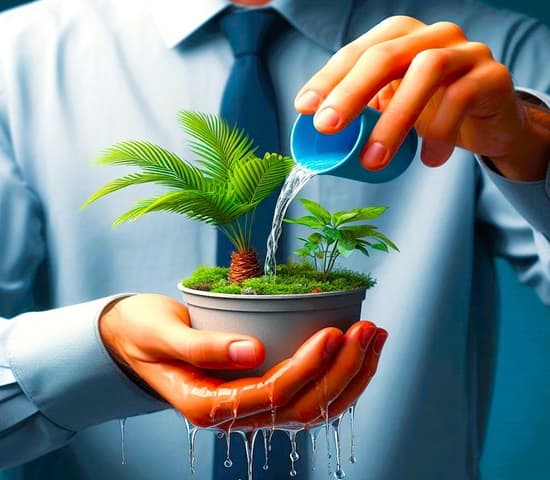 Testing Potting Container Drainage
Testing Potting Container DrainageOne Other Palm Potting Tip is to spray the empty pot & planting medium with an application of Palm Fungicide. To help prevent root-rot problems.
Caring for Indoor Palm Plants by Fertilizing?
Fertilizers can be tempting. Especially when your palm has fresh, bright, green fronds you'd like to keep healthy.
Potted indoor palms grow very slowly. Adding no new fronds, or only a few. So they need very little nutrient help.
Moderation is key. Like mixing a small amount of Slow Release Fertilizer into the substrate preparation. One with the Best Ratio for Potted Palms. This will last your palm's needs for at least a full year.
To Use Fertilizer, Generally Here are Your Top Tips...
- For the best potted palm all-around fertilizer, ideally use a ratio of N3-P1-K2 (or as close as you can get! Remember N6-P2-K4 is the same ratio multiple).
- One we don't recommend is Miracle Grow, as their marketing tries hiding the ingredients & proportions. Plus nitrogen is sourced from synthetics & its proportion is too high.
- Soluble salt content may also be too high - over the max of the equivalent of 960 mg/L of table salt. Which causes leaf and/or root damage.
- If for some reason, you really want to fertilize your indoor palm, try Liquid Fertilizer for indoor palm varieties. Follow instructions, except dilute it plenty & give it monthly at the most.
- The best time to dose it is during growing season.
Beware of over-fertilizing, which can lead to chemical palm plant burns & damage.
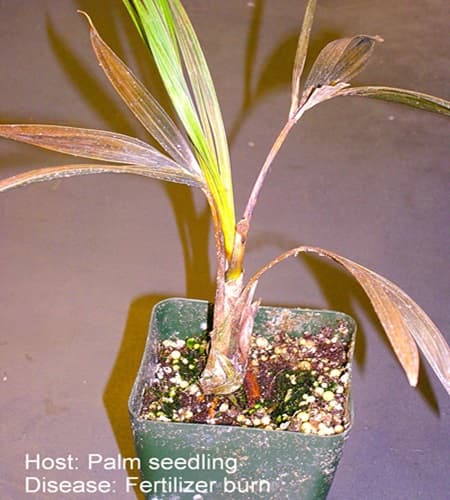
Watering Tips, for Your Indoor Palm Tree Care
Now think about watering. One of the simplest, yet most important ways for no worries about your Indoor Palm Tree Dying.
Were you wondering if lots of water is good when caring for indoor palm plants? Ahhh, you should resist overwatering. That's one of the most common problems that indoor palms experience.
Too much water can lead to root rot, diseases, nutritional problems & more. Take it from me (killing some of my early plants!), none are fun to deal with. Prevent giving excess water, causing waterlogging.
For How to Water Your Indoor Palm, Follow These Steps:
- The best practice for watering new plants, is to keep the palm's planting mixture uniformly moist (not soaking) for the first four weeks (six weeks for larger plants). This stimulates roots to expand out of the root-ball.
- Afterwards, judge if your palm is getting thirsty. Once a week check the top of the soil for dryness. If that top inch of soil feels dry, grab Your Watering Can!
- You could check the palm substrate moisture with a Soil Moisture Meter, instead.
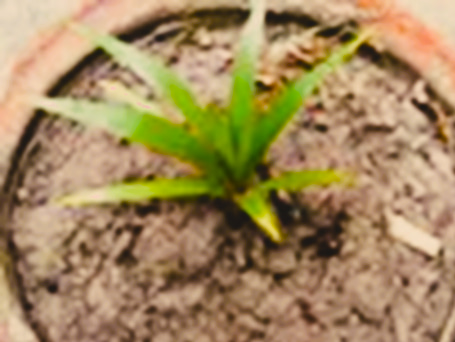 Drying Out Bottle Palm Sapling - Sad!
Drying Out Bottle Palm Sapling - Sad!- Give enough water for a moist soil root zone. Make sure the Container Has Opening for Drainage, where you'll empty the excess water that's filled the saucer.
Watering Cautions When Caring for Indoor Palms
Does your tap water have excessive mineral content? Ours here in Tucson definitely does - having to regularly Remove Whitish Deposits from sink areas. If yours is similar, you can switch to watering with distilled water.
Or about once every six months, you can give twice your normal watering amount with distilled water. Be sure to check the saucer, discarding the excess water. This process removes salt build-up.
Another Concern: Winter water temperatures. Water traveling through your pipes can dip below 50oF (10oC). Potted palm roots can become distressed with water temps under 65oF (18oC).
Handle This, However it Works for You:
- In winter, have a large container of indoor water for a plant to source.
- Use indoor stored Jugs of Distilled Water.
- Have numerous potted palms? You can Make Your Own!
- Get tap water, but heat it to an acceptable level before watering.
Indoor Palm Trees - The Growing Guide for Maintenance
Overall, mostly caring for indoor palm plants is an easy job. This Book for Caring for Palms is the best! We use it all the time.
All the following are these palm maintenance needs.
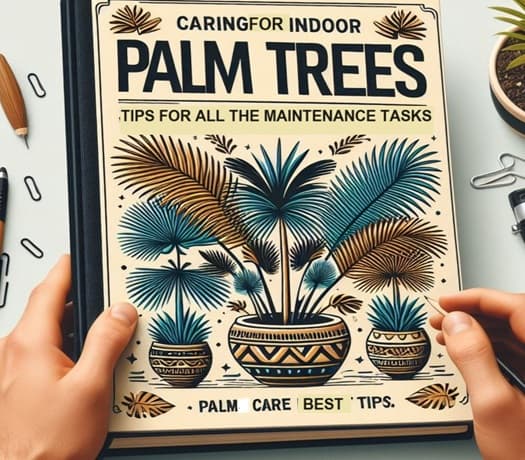
When Caring for Indoor Palms is Pruning Needed?
Indoor palms don't require much pruning. Only Trim Palm Leaves that are diseased beyond repair. Or those totally dried out, dead brown fronds.
Over-pruning can stunt your palm's health, by eliminating food production in a low-light environment. It could give it a sad, bare look. Not quite the lush, inside the home tropical feel that we aim for!
Instead, consider another possibility: growing more by thinning. Some indoor palm plants, the clustering type, can be grown by division. By carefully separating stems, along with their root ball. Planting each it in its own pot.
Repotting to Multiply Clustering Indoor Palms
As For Repotting, indoor palms don't mind being a little bit crowded. Keep that in mind when decided on dividing your plant. When is repotting needed?
- Only when it's definitely outgrown its pot.
- Typically, this happens every two to three years.
Be gentle when moving your plant. To not harm the meristem (growing point), also known as the palm heart. Which is life-maintenance for the palm, by supplying new growth palm fronds. It's prone to damage if jostled.
Essential to not plant the stem deeper than it had been planted before. Which will cover the Root Initiation Zone, preventing new root growth & likely damaging current roots. Any previously above-ground visible roots, though, can be covered.
Humidity & Temp Tips in Caring For Your Palm Indoors
INDOOR PALM TEMPERATURE NEEDS
Most homes have normal room temperatures set from 68-75oF (20-24oC). Keep in mind. That if you set overnight temps somewhere below 64oF (18oC) it can distress your palm. They much prefer warm temperatures.
That's why we bring our household temp only to 64oF from 11pm to 6am, to save on fuel costs. But 50oF (10oC) is the real danger point. They don't like cold drafts either!
HUMIDITY FOR INDOOR PALMS
Most indoor palms love a humid environment. Your home's average humidity level is often under 50%. Most palms do better with high humidity levels, much above that.
In cold weather, with a heater running, dry air can get as low as 10-20%. In desert climates, sometimes even lower in the winter (ours gets into single digit humidity!).
Humidity Helping Tips for Palms...
- Place your palm in a bathroom or kitchen. Humidity there is typically higher.
- Try misting the leaves when your heater is regularly running.
- Best is to provide them with a nearby room humidifier. That may help you, as well!
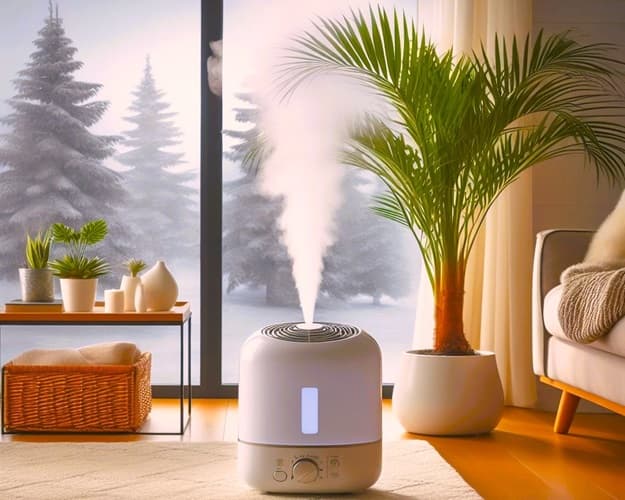
At Home Watch Out for Indoor Palm Tree Bugs & Pests
Low humidity in winter months promotes options for these bothersome palm attacking bugs.
Watching for & Treatment for Insect Pests
The most common pests affecting indoor palms are spider mites. A full infestation is a more difficult Palm Problem. Fumigating with A Natural Miticide may help, when appropriate for indoors. Plus, view chemical insecticides as a last resort.
Preventing spider mite infestations is pretty simple. Give your indoor palm a periodical shower. Literally!
- Using a Large Plant Syringe, regularly squirt undersides of leaves.
- The water washes them off before they start infesting your palm.
- A side benefit is increased humidity levels.
Much less often, scale insects or mealy bugs may attack. Both are sap-feeders. Damaged fronds show the signs.
- Scale signs are yellow leaves. A sticky white filmy excrement (honeydew) is a further symptom.
- Mealybug signs/symptoms are white cottony lumps and/or waxy covering. These bugs also produce honeydew.
Treat by using biopesticides: Neem Oil, Insecticidal Soap, or Azadarachtin. Follow label instructions.
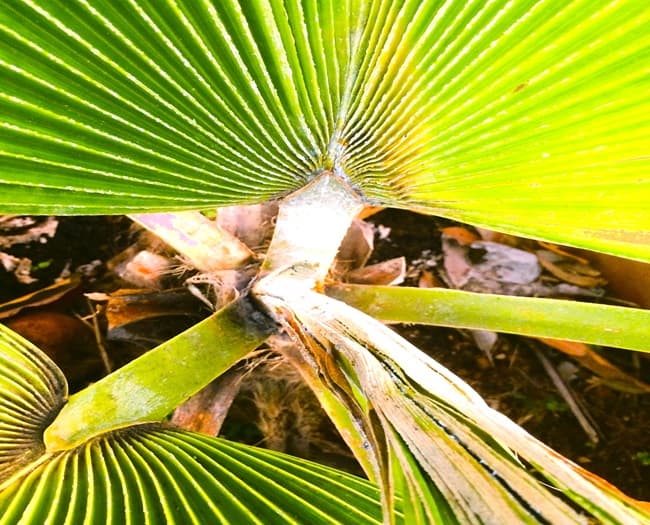 Pritchardia Palm Shows Damage - Bottom Right Frond Not Fully Opening
Pritchardia Palm Shows Damage - Bottom Right Frond Not Fully OpeningEvidence of Mealy Bug Infestation - White Cottony Area
Disease & Nutritional Pestilence Problems
With proper care, disease & nutrition problems are rare for indoor palms.
But if you see brown tips it usually means some nutrient is lacking. Pink root rot might arise with summer's air conditioning, combined with overwatering. This fungal problem mostly affects Cat Palms, the Bamboo Palm, a Parlour Palm & Metallica Palms.
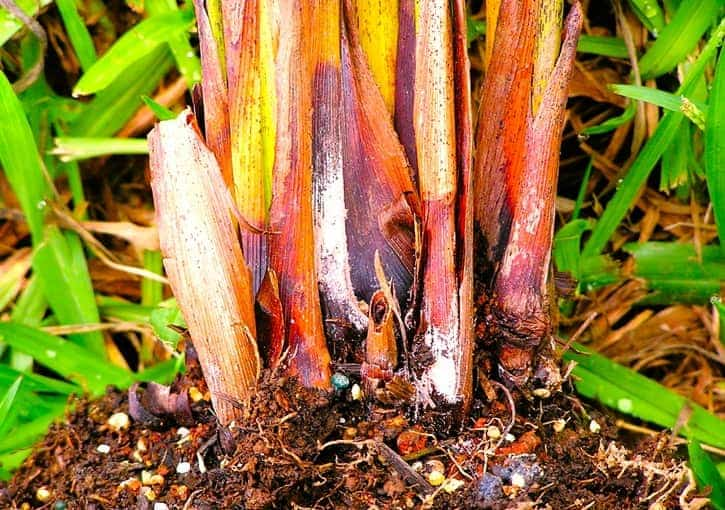 Pink Rot on the stems of an Areca Palm Tree
Pink Rot on the stems of an Areca Palm TreeWhich nutritional issues are most likely for indoor palm plants?
- Iron deficiency is the most common problem.
- Showing yellow leaves (with the stem still green) show up on the lower leaves, those new fronds.
 Like This One With an Iron Deficiency
Like This One With an Iron DeficiencyMicronutrient problems arise when roots are distressed. From waterlogging, nonaerated potting substrate and/or planting too deeply.
Yet by following our guide's advice, you can put worries about nutrition away. Regular proper care & attention prevents problems.
Caring for Indoor Palm Plants Takeaways
Caring for indoor palm plants may sound complex. But once you’re regularly hands-on, you'll find satisfaction. Remember, the best part about gardening is learning and growing with your plants!
One More Tip: be patient. Indoor palms are slow growers, specifically during the winter. In their natural habitat, these palms have an entire tropical ecosystem at hand. Recreating it indoors is no small feat.
You might want to also check out easy palmy look-alikes, like the Sago Palm & the Ponytail Palm.
Isn’t it wonderful knowing you now have needed tools & knowledge for caring for indoor palm plants? You can breathe easy knowing your home can be filled with an enticing little escape to a tropical paradise!
